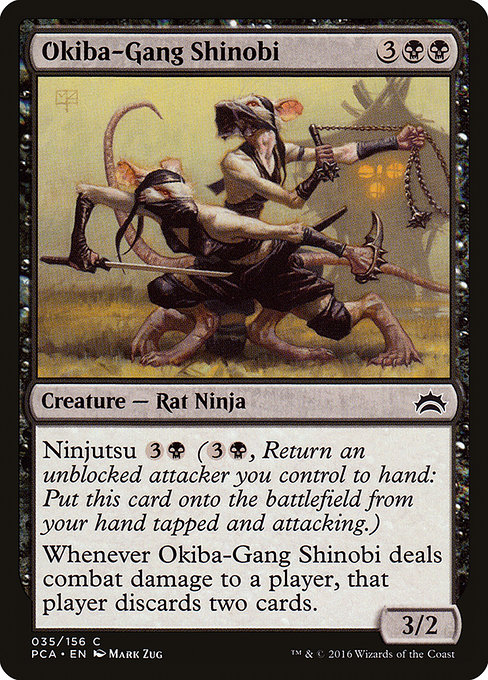
Image courtesy of Scryfall.com
Okiba-Gang Shinobi: A Rat Ninja in the Shadows of Unconventional Effects
In the vast constellation of MTG, some cards whisper rather than shout, bending the usual rhythms of combat and hand management. Okiba-Gang Shinobi is one of those quiet troublemakers—a Black mana creature that thrives on misdirection, timing, and the sweet drama of cards in your opponent’s hand. This common from Planechase Anthology (PCA) may look modest on a scattered battlefield, but its real power arrives when you treat every attack as a potential breach in the opponent’s defenses 🧙♂️🔥.
Meet the Shinobi: A Rat Ninja with a Punishing Card Draw Payoff
Costing {3}{B}{B} for a 3/2 creature, Okiba-Gang Shinobi is the kind of card you keep in your shadowy toolbox for those late-game “gotcha” moments. Its ninjutsu ability is the star of the show: {3}{B} and Return an unblocked attacker you control to your hand to put this card onto the battlefield from your hand tapped and attacking. The payoff? A new threat that lands tapped and attacking behind your foe’s line, threatening to swing momentum in a way that most blockers don’t anticipate. And if Shinobi connects, the juggle continues—Whenever this creature deals combat damage to a player, that player discards two cards. The artful cruelty of a well-timed discard can ripple through a game like a dropped rumor in a crowded room 🎲.
Ninjutsu in Practice: The Quiet Turn That Shifts the Battlefield
Ninjutsu is the mechanic that lets you cheat this ninja into play after shuffling an unblocked attacker back to your hand. That’s a tactical mind game: you sacrifice a straightforward attack for a second, surprise assault that’s already underway the moment your opponent thinks the combat phase has concluded. The unified theme here is pressure with precision. You’re not simply swinging for damage; you’re shaping the opponent’s next draw step, their plan, and their resource allocation. Shinobi’s 3/2 body isn’t just a stat line—it’s a platform for mind games: a resilient, late-game threat that punishes poor information and over-committed boards ⚔️.
Deckbuilding and Cutthroat Interaction: Hand Disruption as a Feature, Not a Bug
Okiba-Gang Shinobi shines in atmospheres where hand size and information are currency. When Shinobi lands and connects, your opponent loses two cards—an effect that grows stronger with every other discard enabler or with strategies that rely on pruning their top deck. This is more than pure disruption; it’s a tempo engine. You’re turning a single combat event into multiple actions—your ninjutsu ability replaces a block with a swift new threat; the damage triggers a mind game where your opponent must wrestle with the consequences of two cards suddenly missing from their perspective. In builds that lean into discard synergy, Shinobi becomes a kind of miniature finisher, offering a second route to victory when the opponent’s plan relies on keeping a full hand to maintain parity 🧠💎.
“A ninja doesn’t just strike; a ninja reads the air of a battlefield and makes the air strike back.”
Planechase Anthology Context: A Common That Delivers More Than Its Rarity Suggests
As a common in Planechase Anthology, Okiba-Gang Shinobi demonstrates how a seemingly modest creature can carry a heavy strategic load. The card’s Black mana identity and its ninjutsu trigger invite players to experiment with tempo, information warfare, and symmetrical disruption. Mark Zug’s illustration captures a quick, slippery motion—flight on a whisper—mirroring the way this card plays: a swift, surprising entry that can reshape the conversation on the table. Even though it’s a reprint, the card remains a favorite among players who enjoy nontraditional wins and the spicy flavor of a well-timed discard cascade. If you’re collecting or building with nostalgia in mind, Shinobi’s pedigree and its accessible mana cost make it an excellent choice for both casual and more competitive Commander tables 🎨.
Art, Flavor, and the Joy of Unconventional Effects
Truth be told, the beauty of Unconventional Effects lies not just in the numbers but in the stories they tell about the world of Magic. This little Rat Ninja embodies a theme you’ll see echoed across color identities and communities: the thrill of turning a robust plan into a cunning pivot. The dual-layered payoff—ninjutsu on one hand and a forced discard on the other—offers a narrative where information, timing, and risk management converge. For collectors and players who savor flavor as much as function, Shinobi is a go-to example of how a well-placed effect can feel like a match cut from a well-worn manga panel 🧙♂️🎲.
Experimental Play: Embracing the Unconventional in MTG Culture
Experimentation with unconventional effects is part of MTG’s living conversation. Cards like Okiba-Gang Shinobi encourage players to try lines that dodge straightforward valuation in favor of indirect pressure, mind games, and long-game resilience. It’s a reminder that not every win comes from a slam-dunk creature with a big butt; sometimes the victory sneaks in from the shadows, via a misdirection here, a forced card discard there, and a ninjutsu jump scare that catches everyone off guard. Whether you’re drafting a mono-Black control shell or piloting a discard-heavy casual deck, Shinobi invites you to lean into the art of tempo and surprise. And if you’re lugging a real-world accessory between rounds, perhaps a Neon MagSafe Phone Case with Card Holder — the product linked below — keeps your day-to-day gear as sharp as your plays on the table 🧙♂️⚔️.
Neon MagSafe Phone Case with Card Holder
More from our network
- https://blog.digital-vault.xyz/blog/post/the-social-pulse-behind-brute-forces-mtg-popularity/
- https://transparent-paper.shop/blog/post/designing-printable-journaling-prompts-for-daily-reflection/
- https://blog.rusty-articles.xyz/blog/post/weaponized-scrap-sparks-emotional-mtg-storytelling-in-play/
- https://blog.digital-vault.xyz/blog/post/how-to-pick-color-palettes-for-digital-paper/
- https://crypto-acolytes.xyz/blog/post/metro-exodus-vs-metro-last-light-which-game-is-better/